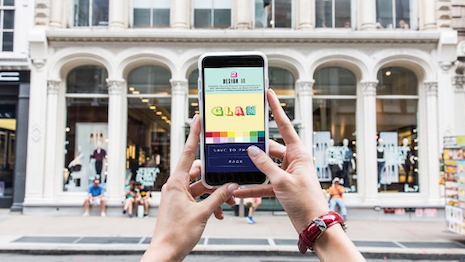By Alex Samuely for Mobile Commerce Daily
Lending more credence to the undeniable correlation between in-store visits and mobile purchases, new research from xAd reveals that two out of three U.S. consumers venture into bricks-and-mortar locations to supplement product research undertaken on smartphones.
XAd’s 2016 Mobile Path to Purchase report, done in collaboration with Millward Brown, studied how individuals in five different countries leverage their mobile devices to make retail-related purchases. The findings corroborated the notion that in-store visits still play a crucial role in driving sales on smartphones, as customers appreciate being able to see and experience a product in real-life before using digital channels to search for price comparisons and reviews.
“Traditionally, smartphones have been considered an ‘on-the-go’ device – a good source for quick and easy information while out and about,” said Sarah Ohle, senior director of insights and innovations at xAd. “Now, the majority of consumers use their smartphones at home as well for retail research, even though all the traditional devices are still in close reach.
“Compared to 2013, retail shoppers in the U.S. are now 41 percent more likely to use their devices at home and 75 percent more likely to use their devices at a store location,” she said.
“With smartphones being used throughout the day, they are not just ‘on-the-go,’ but ‘always-on’ devices. Shoppers may have different needs and wants based on where they are, so understanding the differences in intent depend on where they are in the moment and can help inform messaging tactics.”
Keeping bricks-and-mortar afloat
According to xAd’s report, 67 percent of U.S. consumers visit in-store locations as part of their mobile research, as opposed to 47 percent and 45 percent of British and Japanese customers, respectively.
In-store visits are primarily used for experiencing and touching a product, while mobile research is primarily used to hunt for reviews and price comparisons.
To capitalize on this trend, marketers can tap into users’ locations to better understand their purchase intent and serve them tailored, relevant messages with engaging calls-to-action. These calls-to-action can also be leveraged to convince consumers to visit a brand’s nearest retail store and make their final purchase there.

Smartphone browsing is closely linked to in-store purchasing
“While we see growth in online shopping, shoppers are still visiting actual store locations (two out of three consumers in the U.S. are making trips into stores to complement their mobile research, a 20 percent increase from just one year ago),” Ms. Ohle said.
“With multiple location touch-points throughout the day, different messages and calls-to-action should be considered based on where a consumer is in their purchase journey, and where they physically are in the moment,” she said.
“Messaging that enforces branding and provides useful information works while shoppers are at home, dynamic distance showing the closest retail store is beneficial while out-and-about, and action-oriented calls-to-action should be employed while at a business location. By tapping into a consumer’s location, retailers not only can provide the same level of in-store offers as online can, but they can also create an incredibly personalized and tailored experience to tap into their immediate needs based on where they are in the moment.”
Rising trends
The report also found that many mobile shoppers look to make purchases quickly – such as within one day. Therefore, retailers should not wait more than several hours to drive abandoned shopping cart conversions.
Fifty-four percent of U.S. customers still prefer making their final purchases in-stores, as opposed to 25 percent who make retail purchases on their smartphones. Consumers in Britain and China were found to be early adopters of mobile payments, suggesting that these platforms should make stronger marketing pushes in those countries.

Retailers should continuously update their mobile inventory
When it comes to the upcoming holiday retail season, marketers must continue leveraging location data, loyalty integrations and relevant messaging to drive purchases.
“This holiday season, retailers should leverage mobile to build better experiences for shoppers and stand out among competitors,” Ms. Ohle said. “Retailers need to be present throughout the holidays on key dates while shoppers are using their mobile devices to get what they want in their immediate context.
“Retailers can target customers based on visitation habits and trends based on region, day and time and even target key audiences such as ‘moms’ and ‘millennials’ to provide more relevant and timely messages.”
{"ct":"3bpu\/3bfMe4Tx2XgYKqEuzQZBrXY8tbxTpDgsR4E\/4u1DddGAu6HdQ5OK\/jL02GQUAl6NyxhrVBzNUYFIvTVFXuDhyqADWv0b\/P\/D19ApC7CfGvI5JENX5MyKfJ\/HhULY7YyrU8SIZpODqd2ov19Nh2lRz+uHwkRD+pypQrR1PM2HBgHu+r4wT5TSfaJzQzANKj\/SbCrS89uYGe1TGTUET2aJHDYIo7td8tHMfhboSlM0+pgwd9ZzsDFsCs6GZ1zzMX8P\/7lndmgof1vscbP9dJPEuA8zfNdED91sE1Cf7gh44D\/l2Ztnir2jvxGcLtJPd8N+0xT6x\/EXUjgie4WWnJEwiOcUX\/auRq4lE0r6rrhGKt6gwl7v47TlvL6nh1OWJqoiVR7R6d\/tzwaYwebnVn6FmhFv15zLhN5RicXPjObPFfRDa+JfQKqZkklTVvjy8KKP3CkfTfc5R4qzPVoSwqgTYIx1eBqNk+29xRcAUEfG+6D0DI6I4jy1c4MzNv\/eyRWCLcucJqsWMbB6xUn7aEmqtRdcW\/oEvA2KjQKF38Vd+VVuLhbT1VZT2o6rybG3JndgNgEDoLdaWwE5PDQY+aw9tid5ZGwkvTYEsybjvjmyE7sxzmf17ysn9o77kzawPfU9kN0nnHpEMKhy9kSBnvVPszfxltRRyl0K8pD5YesD65JBv5wWGub7h9vyEPmh\/Nd\/JSHL7RxXLLVfYLn+k750xtJ\/m38WsOO50u7hNVMZIukwGDynIkUZg0fnv3phZ7AHBg2MQBkrKp3pFS4yPLo0vOnlfUkXNEZHowY\/cq\/fh8sUCz1v0SzyTY4QIl+TIsHq+oCE5xvDFC6bpDiBl3tgU7exzxEYsGxLLpPKBSuuaZyFil2AUvR3OPsnaQTo4qWdxAYiEch+XjyvXRBuA5rbMctpnjRdiRZBcqG+h\/QIlFvc6IgE+gl07tcu7DXDi2q\/as8lz\/Ya6ZzsldCWsnya+rTp5neIhaRmmk65mdnN3XNGuXYMzFEZY4BHnkh56ofM0Q2s3Ys9w44FMOtgjfrjVLURTG5V\/mQw5Rq6gGVZGBUAnqhSEBLkcTWFWsr3RiL+Z0AJD04Ym5jSmrKZsC9CM\/nRtCFVwk3WREqJwwbfNMw42vXSr507ooEF5ZMELnann8UvqIQXR3AkAY0OjI+jDVNL6VQKI1YljJskckweaGCWNtnoBILHAH7HSuEu81wunZHkr\/zqyMqI2lJIOZoJQJqgB2z61oyhgyMYR\/ZtSVlOrasr\/agcuABu\/00GgPj2bsycqOzvQzCdwD1\/KImWORSQ1JvDAj2c1hXnW0K3yxasVT88Db+0JcyBjgnawDORxWB0hxjAF7L8+NP+kfg+PsyLcnxTFclcvFlMQqvveok246bNHy5H6xMcimnxpp0A3q2T21ca0TbOESWsO3En+VSC\/BiK+GTExcTrUVkkU8FueCAz9xqYZjwMuRv7GIdmJ+T9GPMFagWdzyeSCNnt\/FjVke46SZejUmLxfg\/9ppJhXcQXsT8mVYGGonYpvIJLxXTRTj0IoO+yUI8QL4X8cJN2GntKrg6AkJTTOzwuhQ0e+7nxzey4v8U4bUOLeSRwak2bPEc3ohzMT398TYb6\/PfVUu6NBHddzr7SEkYcX0U\/0arFLu7bw\/C0ufrSPbFllHNoZqcWg4m2TSCDHWLKB8d0SLWaUxru\/Uab0jyjOPixI\/dITJqh7kZZCvLp+XA3WHTo2DtXNorJL2u35RLSOOfGclaij0AWVzcp9pmSKxg\/J17GJb5k3Tgsm7j9ShKLlY3pfULjVcotPhVuG9I6buS\/fAT7J4+USpA6SXx+KArAstWgFOuDIpEns2OX8aQw3mo\/b0WB0xIkJSOTyU1Ed039KuAHavWAFK5t+1N21Ucle1UfWSX5HXzCR2nvFHVpah\/g9EdxHJAVyR7ezVKRE4m8X2Ich1YSzujh\/iWPYPrExWD4lHJwL\/lZNgacW3fTV3fi1WG8GLx9RjyTFV7aXYpWzCOavQZC\/cc3GOD39uYZlTYYYgFTGGkRk9GmprTAJ+ms3Cm9K2EV4H5oy3+3Ho5DOGdB3c3ehPV7UkP0KTqw58HcQtN8NINYBR5iBT5xDanDdvdsgQTbUAHp3vELDlNm1Oqgo27fPAMeGm6d0GhliDz5KiarlrcwRbw9SQpfvNEqpPIan+jUToTFY7U6unMF8fRYmhmSwrYxinWxGXXfhkk1CpCouGJa2+3azU+n8\/r4NKlgVcLGcJ2Esiaye1c60ls76WCYlshD505ykOJxvrrJcIlFm4p5S6LyhWzDacCpC5INeFz3Iivtv7ddIb3HN1pq3vfsOd+bpNWfZk+1zvzFcuWOXz8zFOvgqq\/9ZkRy\/\/BkYE\/N36UDuCjLmJ+XAQ34NPjajRh4wDv9VCRuqVdaUjCK34+vaL9wd1sUripuleK33UWRXwtnUujSMqQSCzYZ4p7PACC8bixLHs1lHTHW\/IRuWznQmgbeczlhHa18dV9TSP6Jb8IxDLu5CM4Cl5OJz1t5SjdODriL++v+WxgorfL9awKewXOojBtCBr9xNtMAXTgLEtJ7iPMsuRw3imlgRijn46YMd7MqjT7d+nlUi0npirixDdPp84VPxsHdgi6Q6jLGeMMVdoqrPOrBWhMsYuTbFBoae1ZMaqbDqRUVd5idrt8MGKh78OKnTJ3eN5LBENvz4OHDrc\/XIdO+bNStje5WBdoFYv9AfG98hbKVJ4RsB6Vub3vU2v+dCPAs4Ue92qRHVhK\/64JcqavgG2L2Bb3CK7F8AaGRFjxSmqtyMcif9TzyVVpSVCk08wtFUUDdJE70pGEgh\/Z80TkBJQkz\/LZ\/ZTmtiKXPZ0bk0Qdru7qM1GYxYgqlputsgdwsBrQ9XLU0MOwV9o\/MgW0OqZ8nU4YpE3GQ6vhHbhi0YKM8tPfi8kZY3wzhcQoHwPduvXR4zaZekooKl8IwOZA+kfjH+UIETD0uURCfvRZym2kuOVuYo088gkyW0RdUBBFobigk6LlcoxASZhyXeaSSZsFz4KO7xdITaF+R8xrZgy+NXquxVsX\/5KGuT8EnmmqKi+FHFnYaYc3Si2373TvzbwjLumjQS\/TEBhcvaS4BA2cbZT4TaQljhnqAgkMmJxLESbUB10sJONRtTOpvBUYS5WsLJ4r5kdq\/48e6ij+FGkofdbhzGbascS26etsMAm3KuwLWHkTel6c1gEuvwwocBJvm4yAt7WJ35WmlxomwD02kJ7Rbib6LnTyHFDO0vT844oRqD4gNht9mDDM\/BFMkPGq7AcXh2EeYArB+AySWn+DczQgRFmPVWqQ8qoDdAUdZCpbxX9cCyLvGw0kZSPXM2hrLY\/2idl4R7GogxxU8pBD6ZDpvNL37h1onZgzjv\/hIbMxl4ZPkeDeD0whj4aC67573GgKcN0syq3AfKIliQfOCKWa2onNaxB3CN+vwN+zJJTLpxRCXb8DGdqdYNPBOKAz7SqCi1rYEqRmBWuP9ehH8CiM5SXQlCjyMo6sqsJ1IL3MKCRMzKNL0P60HFpAYI7esHYc27SfMZnkVBz\/HeEO5VJV6bjhrVYSLfVja4uzL87kwIFcAO\/T0Y7jQtRH6o0Gi8ftehc4ao3cARRgKu\/kPVv6ftEYBecHfFGSeNDM25eij8V96DjxbhDH59mzCKSJ+z6M9XU4Yec+HHHzg4X2qlZw587xQY+P8\/9DwuFt5to9SbMyYlho8jAXPv19KPtqN9DyukoDnAc5wg8OW+IXjyDoc46bOYsWxhuyfTpqcAauzWRnphZGJVYmFaGR+jRchPt4lufoiTU1sr\/a\/lTM\/OSuoD0ck81wK01Z2jSwIN7rZ4AlJ29xEBak1pb9mK1Omvb0xzvxLBoe4ra5Edc5A6XkH\/WaoXHGQHe4OynbmSBNl+LvsGyLi7cUaO28LKAWjc4JjIoES+VEUgFmoGcd+jpxVFKTdT8oEiTTUeJTPrSSEwyYx0dhHzlpV\/I5ZrTpcyHFbhgOLZLug59SnEsoNJLIxtKR+1mTwBsQq4PEK8LmRAedIgi1yIYj\/Pxg06\/HbhqJr3Ymrbx4UwwDOwht9g\/gUso07TJy+SyntYHiGslUkblUX9B9TS+OGP1fMOq9c3vqxazAxAbaKEZVCucBgJeDx+Vh6WDy\/m4nBeliIMy32WY0LsyJ0GCWZyR9yonb9ngtyPuncw35\/mbY92IJ4sJ2PbP87ZFsO2ptBPz3TBE2PyM04bItrykj1wionjOV8mIDMsWwg3fmf9mwm3t1Gzw7nG0RhGGyhwWrg5yaT9zcXdNHfcc6M5LEqcQB4eXt8Uf7ZgK17Vkx9t8YQk4yWWR5SYAPPg9fiGSfXyLyMprOjSfqPk9YnJ2fHwFTevDyFTrpkXkAcra6kMjjJNEHC+CxTd6Wx6WQMQt2+PgjVFH5yNPT7i5gNrkpRPlzESIEOeLGbx0ydAps8MFBXn6JFA\/+\/iY\/8klz9LS43LfGWvtgKFhhC76OaDZQ99cf4WHTtuXr8vJl3mf5Sv0DgmjfA3vsaCao4\/tuEkB9E56r6GHFKo6wEDFAjx6o1p9Nepmc7IoOXmCiMo8cvgBr07p8WzS7UK+XTdbEOUS3myFA20EaeYCek+OF4z5RMgYYMfP1iEb7dsfH4nGYh6igaK8mm8\/6nHEbrelS2Fz0QzvoxFILWYpoTzHZh4deV6YFgLhGMMvVBe\/aYjPjbdgQMZoEFb0x2PrBY+ivE3rMDRASkFUK6Dfl+ymC039wf4GxeQJEM+2R06l3b\/1sb39BAmBq\/nKcSs8HzVJSOtlsBy9gh3tpQJ9VmVja+1Cg65bhiE0YlO9bf3cF7hPYGGSRdk0HlVlBvAilI89JMlFYjIrSMDbVkq2+xoCI1ei4WEjZtC4+Sd6BMiihkr22XwbtfIZVuLvTbVJr136ncMVofjSxNVcXwOseDazop2OIQJgA2WfVzlG5lobCIYeYFBJIx4IciIwz6plojXEyXWsz0v5oWDFAymYhxELkWP2xo8MHocZji8MeAeE3jnYacx2K40x93Q4zYYfz1pNhEqtreTfaGSKShih0wql4PQsStEgJcpiEHM+4Ki51ah8RpCy8qZJnx5UVxA4+aN5TsxoDTX5+QJaB2zookzoA8XR0dsTf1+uZKpz+MTKx2vmwyT6T\/NQGMFEwkJcOiwOQdOEM\/+SWPp\/QA1hvLV8gs0sf4dWTMUnRDiXhyKjcc1oL66PODn46ex4SL1xklMd2cFllUXKH9wk07pRcS5F7NLyg3RPBRa\/t1RZ53Sok54Vc5zuvUV8HxyIi274ycEGbvis807LyXRjaZsD1Rgl0f60txSDHmAcMj1FAJC2FkEd5qhxs5oDdKouaEd6eBsx\/bLa01klyJTiLENkH\/Ptm9Uv0cK58wRep7HoaRowqmnD900EXBJwVPI2Ls\/PN9Hka\/VE6I2aVbq9jXzkIMOyUaBtuu\/4l1kJuX5veMhkzqjq8bXFkyJZ3VBznosjnPzKp9JGFI2nLcIKW9mRiu5t71P6ZcYeS0SkHlxb9JlS6TWsj\/adOUIKpyIXfcvIYJou\/kphsm0HlH9LjQorFhMKf1o\/noMp3odF1gjh80W1JN1JkXB71dbO6X6HDPmT3kIwn5enEkELDImMDE8tSn53b8hJ4vNcvppbISzBFpTrBfNed4UoQx8PGFkuwBiHMJ7ynyxebDo15XwyfClBP9uTSBpadVBbvayi+1HpHdfCgbSdcWWKXfASxnAFZOdHN8Bdcow6UqOtJ5GHsJps08oAksDIUwlFCf36KO9Wp\/kzyagcYHTpuzXuxBZvRMKxD+K5Yz9mYbuSW2EqpSXN6nC0H6y5RQTSArFCdSM3QXmQoL3+dvRd3bTWjpSTaf8+F\/HTdJXZisLOD+zrth+pi15abyg7iTZ4tOk7fHxUB60jU3OkDfyWzHvBq7Bjzgh9bT3mYwtJxjfgkB4E3bh14jgSq3VPcfqb9i6AIFLUAhLKBBs7JPAtBKHpJpkNGhpXUatGWtPlzRCh1GVSnSOYfpHCESzMWLBxMSAbkqS0MG7irob54n9fGq31PeYDZnssa4Q6ZHv72soZE5aVEikCs1x0BjrQWt9IDjGdk\/52s0Fu9CUffDwCZDI22rQ75EBJGIZE1e3jWvA8lPwAZFU4xjacYwmCc+6CDjGOxqShtPX6Yy463UgVEIDfq0XoW1meXuekyVhg7uFnPmD2ZZrQmQrwWHtqdPD3xQbO5ANHoqmoWlXPYuJJ4eQ3+l4DrJVYrE8UW\/e6wRxAy03YuDQXrlpjTy9D0k9\/4aHcMtZCusT92T33gm6ux+6GFdg9zD8mEpsp\/tWHvCNzU8qGffr2O8XnP2Zax3FIoAGdjE1TqZ8z\/r3NlPYOKU\/mZckzPUhZ8kw98h1i1Owb7d0XVhSvJDoN4wjdSVB8CaQLn9upx6LP7m4fJQTtom4b2vkgHLMjN+Seqpy1Ho93b91NIgDziNug+geDXKydnwRBFfCheCiLNKmh6lEW5XmkZ3C6nk3N1JYmKDhdFeFm2FNMEQ4u3J3fPpZgI0E4ZeCJklqSLCRI9B8LggjQO1t2665feLJbQPmxaa1PutL07TbJoW1upewPV5wn4eeO3kZ+VuzNKkGT+G5LMqHlj9YAvpnF+27z7hDnB9XqlZi0tqQ7pJIxPTDMAO2cgcz04DG6jnyj\/8D6QifAk0j1QG9wl+Ppb\/GZu2vWu+ExLfLJ1nGy0qB+rwMwtpSwcj+FX4y7aGMRFYxOGcfvM03o2QLpUtlpXbHoMm6Ksx6xHitjWRGbcE6+ZCkqsJEVfb0I9VewRsGup5UCY\/jDxNS4HvtZ6hEzoQqBourUyprKVk\/PGdBehg9b\/Retlst3z\/CDI+VeFFq4FuxdoTh8foqN2j4dDLDCF1vcJV76bIOx\/cHM0Ktif1X9oKsgR9GYShjmeSFrwrZfZk57\/WGAti8J4xW2iF7d0vtzxtEIvEri2l3RqWitpru0d0uJDcxFSowJwrOpvXQvNIyppogaxi3vD73UW8VDrhs0vD3W+dcGjYwOdjF11eufKN+YJi\/yhDD\/sLBmWQMI1AgAb299EHWHUA+qL1jsL5zYCgL7kgalZwbLkJw4Ele9YidyNSarxGae6S6Q8roSIfTRPgs4BQXOTi8S+oKDgiXWfHvQVVQlCvmWTtculdqWLocZWCJciK6k1YMiP\/bYdRE1N46j11tcFE6GDF8W6O+81iNiOodttgabzsyB1NFe\/R0jyvKOSrIegg7rUbnmBzSC2eREErkOujD6NnUIQdUcdW+hLjcKETNADjYYD8vMdJF2cxixaWK3zIivl6mCog89cme3\/fNpnQmGEfKYIsfDFOTSfnVzI6MVfwA5z\/MbeBn\/iK27ZBnZzgUT1lvoQ1oTI5iH4JdSbggPKBnvUymI8Gl+k2m1b1r89xhkI9odz41TRE4G7da9Ji1gHH\/RrWm5rK5wS0xS3FjdulHUcfLvwnVPC47HyxR3466qfa0nj3aFVkGQ7KrpK9U3fsKqQ9ufxoCUZhhInZiVDLBszefgNpJB8hkeL1Xhcv1+dlLiT9rXVwNthH7YZkXEOwblOis5ecTZE4rl\/fy4\/+TmFnIVfaiaNx2TcUWZvkKJK825jX4\/quk6RB0BEEzmoUILzpgcPo01RoZ1aqJVSBLk0pAdUkAtjjhPLK9Pl8awYm5lINHLQ3GkB7mH0iCfv+\/W5RssGurlJVkBpggRclsCXrZJFX+Xjc71VnAymb8fC+datpMFMm6miDL3MJRwcawWE69PPkjJJ0oYfqUHCpkkQQT2vZRM2U\/+iRC5YehMEvQYkE47ZopWj4YF6vrR0sby2yyQ3w+YaPuUeuXTZKRK9KVrNEhSRI2JII6wmJDKy1Hu602SKT6grXP9dB05mb2TPymdPe+wdAhEkiv7l056412Z1j9GcVxspPwUsggPDqglnLeOeT7Jobot9X2cjbhAvzlnfF2myqB5rpK81xDGVlk5sx\/FggsiQnHEEnpxE3hKee5TEaZhSlaIJvy6JHVNjnr7hzh2\/74g489GajgvHVHytX2fK","iv":"737c285490f3768873a83ceb5baf1b23","s":"dcfc10a5a056a4ff"}

 Promotional image for Bloomingdale's sweepstakes
Promotional image for Bloomingdale's sweepstakes